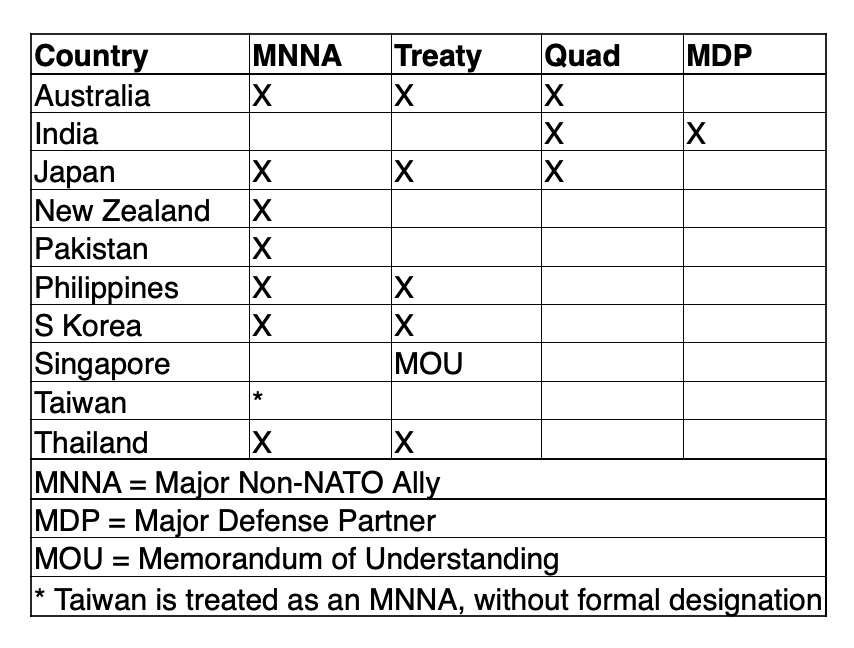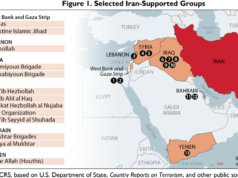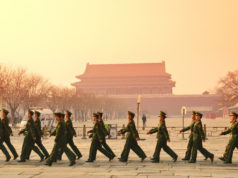If Hong Kong was breakfast, Taiwan is lunch, then what’s for dinner?
When playing any strategy game, such as Chess or Go, skilled players look ahead several moves to win. In the case of China, many Asia experts believe that Taiwan is the next country on the People’s Republic of China (PRC) target list. The PRC’s campaign may begin in the period between the Winter Olympics in China early 2022 and the next Taiwanese election in 2025, but no later than August 1, 2027—the 100th anniversary of the establishment of the People’s Liberation Army (PLA).
Few analysts look beyond Taiwan to other potential PRC land grabs. So, if Hong Kong was for breakfast in 2019, and Taiwan is for lunch no later than 2027, then what’s for dinner? Specifically, after it digests Taiwan, what region does PRC plan to acquire?
 Key to examining where the PRC can expand is the set of opposing states. U.S. allies are listed according to their relationships with the U.S.:
Key to examining where the PRC can expand is the set of opposing states. U.S. allies are listed according to their relationships with the U.S.:
 Countries cooperating with China include the Islamic Republic of Iran, Myanmar, Laos, North Korea, and Russia. Pakistan, Sri Lanka, Vietnam, and Malaysia, cooperate with U.S. and China. Consequently, due to Russia, Japan, South Korea and the U.S. territories of Guam, Hawaii and other islands, China cannot expand east and northeast without risking a major war. To the southwest, China and India are at loggerheads—including minor border clashes. PRC’s remaining option for expansion is Southeast Asia and the South China Sea (SCS)—also called the West Philippine Sea (WPS) or the East Vietnam Sea (EVS).
Countries cooperating with China include the Islamic Republic of Iran, Myanmar, Laos, North Korea, and Russia. Pakistan, Sri Lanka, Vietnam, and Malaysia, cooperate with U.S. and China. Consequently, due to Russia, Japan, South Korea and the U.S. territories of Guam, Hawaii and other islands, China cannot expand east and northeast without risking a major war. To the southwest, China and India are at loggerheads—including minor border clashes. PRC’s remaining option for expansion is Southeast Asia and the South China Sea (SCS)—also called the West Philippine Sea (WPS) or the East Vietnam Sea (EVS).
The Nine-Dash Line & EEZs
The PRC claims 90 percent of the SCS based on “discovery” of a 1947 map that consisted of nine-dash lines. This map was updated in 2009 [see map]. The SCS is the fifth largest ocean in the world—it is 1.35 million square miles and is larger than India.
 The PRC claims the SCS in contravention of rules established by the United Nations Convention on the Law of the Sea (UNCLOS) regarding how much area a country is allowed to claim as its exclusive economic zone (200 nautical miles). The PRC has advanced its territorial claims to the SCS, and SCS countries have called the PRC’s expansionist policy illegal. In July 2016, the Philippines won a ruling by the Permanent Court of Arbitration in The Hague against the PRC that concluded that “[t]here was no legal basis for China to claim historic rights to resources within the sea areas falling within the ‘nine-dash line.’”
The PRC claims the SCS in contravention of rules established by the United Nations Convention on the Law of the Sea (UNCLOS) regarding how much area a country is allowed to claim as its exclusive economic zone (200 nautical miles). The PRC has advanced its territorial claims to the SCS, and SCS countries have called the PRC’s expansionist policy illegal. In July 2016, the Philippines won a ruling by the Permanent Court of Arbitration in The Hague against the PRC that concluded that “[t]here was no legal basis for China to claim historic rights to resources within the sea areas falling within the ‘nine-dash line.’”
The PRC has conflicting EEZ claims against Vietnam, Philippines, Brunei, Malaysia, Indonesia, and Taiwan. Taiwan is in part of the area included in the nine-dash line map claimed by PRC. Therefore, taking over the rest of the SCS would conclude the PRC’s initial expansion into southeast Asia creating new boundaries with the Philippines, Malaysia, Brunei, and Indonesia. The PRC’s new borders would be a short distance by sea from Singapore (only 375 miles from the nine-dash line), Cambodia (550 miles), Thailand (660 miles), and Japan.
Assuming that PRC would control Taiwan, Vietnam, and the Philippines would have the largest areas of conflicting claims with the PRC in the SCS. Vietnam claims an ocean EEZ of 538,650 sq mi. The PRC claims 70 percent of Vietnam’s EEZ (~377,389 sq mi) with their Dash Line claim. The Philippines claims an ocean exclusive economic zone that covers 874,064 sq mi. The PRC claims about 50 percent of the Philippines’s EEZ (~437,000 sq mi). The small country of Brunei would lose 90 percent of their EEZ. Malaysia would lose about 40 percent of its EEZ. Finally, Indonesia would also lose some of its EEZ to China, northeast of Natuna Island. 
Exclusive Economic Zones
The SCS large oil and gas reserves explain the PRC’s interest in the region. For example, China claims that SCS could hold as much as 213 billion barrels of oil, or the equivalent of 80 percent of Saudi Arabia’s known reserves. Natural gas estimated reserves in the SCS are about 16 trillion cubic meters, composing a third of China’s total oil and gas resources, and equaling 12 percent of the world total reserves if they gained control of the entire SCS. The U.S. has less gas reserves than the SCS (but more than mainland China) with an estimated 13 trillion cubic meters. Chinese officials sometimes refer to SCS as their Persian Gulf. Other economic reasons include the lucrative illegal fishing conducted by Chinese fishing trawlers in the EEZ of the SCS countries. The economic potential under the sea includes vast fish resources along with the largest coral reserves in the world. Fishing wars between the PRC and the many nations in the SCS have already begun and frustrate SCS countries.
 Sea Lanes of Communication
Sea Lanes of Communication
Another factor that guides PRC’s expansion is commerce that transits through SCS waters—sea lanes of communication. By securing the SCS, China would prevent other states from affecting their commercial shipping lanes while holding at risk other countries’ major economic trade routes. It is the second most used sea lane in the world.
Could Vietnam be the next target of the PRC? The PRC has an 800-mile long land border with Vietnam. On 17 February 1979, the PRC forces crossed the border and invaded Vietnam. The PRC cited three reasons to justify its aggression: the Vietnamese had attacked the Khmer Rouge of Cambodia, the Vietnamese had occupied the Spratly Islands which were claimed by China, and the Vietnamese were mistreating Vietnam’s ethnic Chinese minority. The fighting ended on 16 March; both sides suffered approximately 30,000 killed, and the PLA withdrew except for 23 square miles. The Vietnamese call this war the War against Chinese Expansionism whereas the PRC called it the Defensive Counterattack against Vietnam.
Vietnam and China had border conflicts until the Soviet Union fell in 1991. Sino-Vietnamese relations improved until 2012 when Vietnam claimed Spratly Islands and the Paracel Islands as part of its territory. Conflict was exacerbated when Vietnam claimed oil and gas rights in its EEZ, and the PRC rejected that claim. Between 2013 and the present, the PRC attacked and sunk some Vietnamese fishing boats. Vietnam is a communist country and has sought to continue good economic relations with the PRC; 22 percent of Vietnam’s international trade is with the PRC. However, Vietnam does not want to become a vassal state as they have been treated during China’s history, Vietnam’s leaders have sought to counter PRC’s influence by acquiring U.S. defense equipment.
The Timeline Thus Far
To avoid a direct conflict with the rest of the world, the PRC has two options modeled on Russian takeover of parts of Georgia and Ukraine in the past two decades: (1) a “sea-grab” of SCS islands either by salami tactics (a few slices at a time), or (2) many islands at one time.
One likely scenario would be for the PRC to take a few strategic islands from one of the other countries that control these islands just as it did against the Vietnamese or Philippines. Another scenario would involve a false flag operation, such as a staged action against the PLA Navy or the PRC Coast Guard or a PRC fishing vessel to instigate a “justified” reprisal. Conveniently, the swift action would involve a sweeping takeover of some or all of that countries’ islands in the SCS.
Focusing on the SCS, below is an abbreviated timeline of important events:
1951: PRC Premier Zhou Enlai claims the inviolable sovereignty of the PRC of the Spratly Island and the Paracel Islands in SCS
1974: PRC takes the Paracel Islands, Yagong Island and Crescent group reef from Vietnam
1988: PRC takes south Johnson Reef from Vietnam sinking three ships and killing 74 Vietnamese sailors (Spratly Islands)
1992: PRC passes Law on the Territorial Sea claiming most of the SCS
1994: PRC occupied Mischief Reef from the Philippines (Spratly Islands)
2009: PRC publishes an updated version of the Nine Dash Line map claiming most of the SCS
2012: PRC takes Scarborough Shoal from the Philippines
2012–current: PRC military buildup of SCS occupied islands.
American Policy
On 11 July 2021, U.S. Secretary of State Antony Blinken stated, “an armed attack on Philippine armed forces, public vessels, or aircraft in the South China Sea would invoke U.S. mutual defense commitments under Article IV of the 1951 U.S.-Philippines Mutual Defense Treaty.” The PRC could interpret this statement by the Secretary of State as a paper promise since the Obama Administration did not interpret the treaty as covering SCS islands. The PRC tested U.S. resolve to protect the Philippines when the U.S. did not respond to the 2012 PRC taking of Scarborough Shoal that is clearly within the Philippine EEZ. The PRC demonstrated salami style encroachment on Vietnam and the Philippines. Vietnam is more exposed to PRC aggression by the lack of a defense treaty with the U.S. Recall that the PRC seized the Vietnamese Paracel Islands in (1974), south Johnson Reef (1988), and harasses Vietnamese fishing boats and oil exploration efforts in the SCS.
If the PRC decides to take some or all of Vietnam’s or the Filipino islands in the SCS, how would they conduct the operation? The main PLA Navy and Air Forces needed can be forward deployed from Hainan Island military bases to the currently PRC occupied Spratly Islands, Paracel Islands, and possibly other locations, such as Scarborough Shoal, that will likely be militarized in the future. 
The SCS Triangle of PRC Controlled Islands
Examining the above map, note the following regarding the three main island groups in the SCS according to their territorial claims:
Paracel Islands (Northeast SCS): China, Taiwan, and Vietnam contest their sovereignty. Since 1974 China has occupied them after forcing Vietnam out.
Spratly Islands (central SCS): China, Taiwan, and Vietnam claim all of the approximately 200 islands, while Brunei, Malaysia, and the Philippines claim some of them. Vietnam controls the greatest number of them.
Scarborough Shoal (Northwest SCS): China, Taiwan, and the Philippines all claim the shoal; China took control of it from the Philippines since 2012.
By controlling some islands in the three strategic areas of the SCS, the PRC has the ability to expand its possessions rapidly and to protect them from interference from nearby countries and countries outside of the area.
Note: The PRC made non-binding agreements not to militarize the SCS including Scarborough Shoal with President Obama and Secretary Clinton in 2012. The PRC, to date, has abided only with its promises regarding the Scarborough Shoal. The PRC has broken promises on the SCS and violated its treaty with the UK on Hong Kong. The PRC could also break its promise to not militarize the Scarborough Shoal.
What Happens After Dinner? Dessert
In conclusion, the above analysis argues that after it occupies Taiwan, the PRC will attempt to take over some of Vietnam’s and the Filipino Spratly Islands. In a worst-case scenario, the PRC could seize all Vietnamese and Filipino EEZs in the Nine Dash Line area. This strategy maximizes PRC’s security and expands the sea area that they can control for its resources, as well as controls the shipping lanes. If the PRC regime decides to control the SCS, they would have to take all the remaining countries’ islands within the PRC Nine Dash Line area, such as those controlled by Brunei, Malaysia, and Indonesia.
Guermantes Lailari is a retired U.S.A.F. Foreign Area Officer specializing in the Middle East and Europe as well as counterterrorism, irregular warfare, and missile defense.





